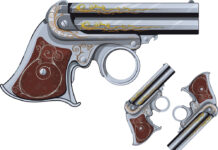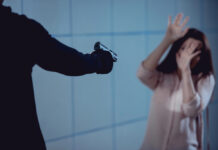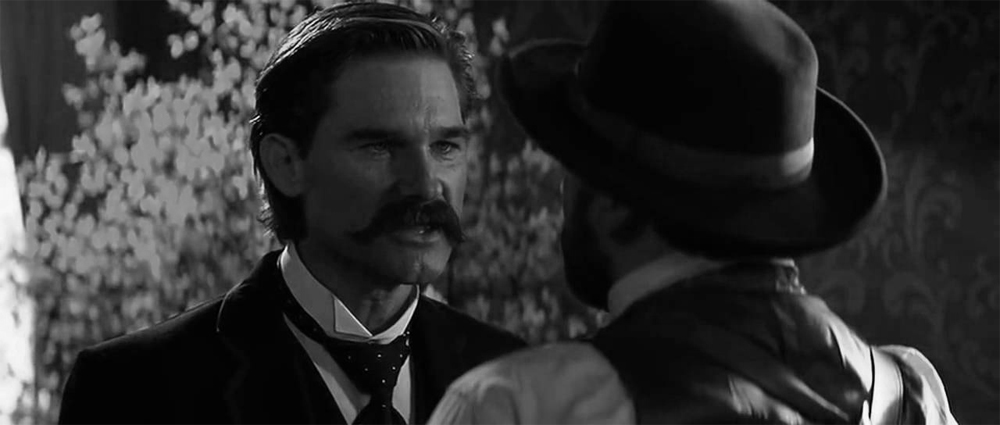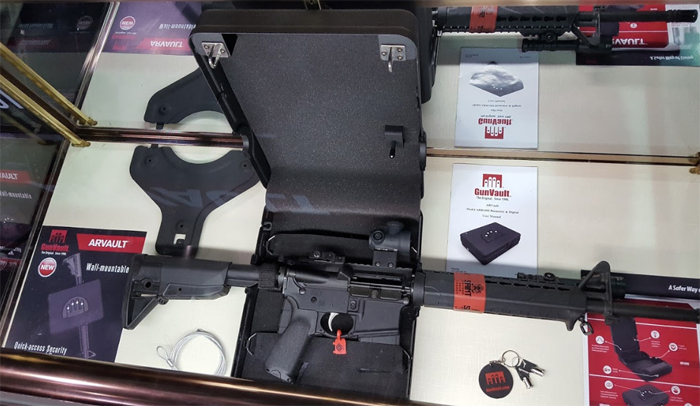![]() In the first installment of this article, we discussed the fundamental skill of actually being able to hit what you are shooting at, relevant to a gunfight or self-defense shooting scenario.
In the first installment of this article, we discussed the fundamental skill of actually being able to hit what you are shooting at, relevant to a gunfight or self-defense shooting scenario.
In this one, we will discuss some of the issues surrounding the necessary prelude to that act; to whit, getting the concealed carry sidearm from the holster, into your hand, and ready to shoot, in time to actually be useful.
The simple fact is, outside of some very limited situations where it is both legal, and—more important to me—socially, acceptable, most normal citizens do not open carry their personal defense sidearm. There are a number of reasons why open carry is quantifiably dumber than a box of rocks that were rejected from the stupid mill, but that is irrelevant to the current discussion. We are, after all, specifically discussing Clandestine Carry.
When it comes to drawing the gun, from concealment, in a self-defense scenario, there are a number of factors that we have to recognize will play a part in how fast or slow we are able to present the weapon to the threat. The first—and least influential, actually—is the raw, physical motor speed with which we are able to clear the cover garment, acquire a firing grip, rip the gun out of the holster, and present the muzzle to the threat, while acquiring a sight picture, and taking up slack in the trigger, as required. This, of course, is the one most often focused on in shooting classes, because in a lot of ways, it is the only one we have the ability, as teachers and trainers, to improve in an objective, measurable manner. I can—and do, regularly—bring shooters from a >3.0 second draw to first shot, from concealment, to 1.2 seconds or faster for the same, in less than a three-day class…and I use ridiculously stringent marksmanship metrics in my classes. That is really not even particularly difficult. I’ve had students break the 1.0 second mark—again, from concealment—in as little as a couple of hours of personal instruction.
What is more difficult is confronting the other factors that can limit drawstroke and presentation speed: fear, and disbelief. The first is relatively easy to understand, but is often more complicated than inexperienced people realize. The fear factor may arise because of the readily understandable, “Oh my gosh! That fellow is about to cause me grave bodily harm!” The freeze aspect of fight, flight, or freeze kicks in, even if just for a moment or two, and your sub-1.0 drawstroke has suddenly, in the light of reality, become “he never even had a chance to reach for his gun!”
Alternatively, the fear factor may arise out of hesitance. “Well, what if I am mistaken? Am I really justified in shooting? Will I get arrested? What will my friends/neighbors/family think if I shoot or kill someone?” While we beat our chests and bray about our macho willingness to “face shoot bad guys without hesitation,” interviews with actual self-defense shooting veterans, combat veterans, and violent crime victims who didn’t use a weapon to protect themselves, all indicate that this is a very real, very common issue in shooting situations. This self-doubt—for that is what it really is, at the end of the day—is just as lethal a form of “freeze” in the fight, flight, or freeze instinct.
Related to fear, mostly in the first form, is the occurrence of disbelief. “Oh, he has a gun! Well, he’s not really going to shoot me!” “Oh, look, they must be shooting an action movie in this crowded shopping mall! Look at all the people screaming and running around, covered in blood!” “Well, he’s got the gun, but as long as I do what I’m told, he probably won’t do anything bad, right?”
These are issues that are far more relevant to getting your gun into action, in a timely manner, than whether you can break a shot on target, in sub-however many fractions of a second, but they are also very difficult factors to teach and train in a one, two, or three day class. They are, ultimately, the responsibility of the prepared gun owner to develop a personal training and mental conditioning program for. This article installment is intended to HELP you consider some ways to overcome them in your own mental conditioning and war-gaming. Failing to acknowledge and address them will result in, ultimately, a real-world drawstroke that is completely unrelated to your square-range, fast-draw, timer-measured drawstroke.
Overcoming Fear and Disbelief
The best trainer in the industry today for actually TEACHING dealing with these aspects in a hands-on, drill- and scenario-based environment, that I am aware of, is Craig Douglas, of Shivworks. A former Army Ranger, long-time undercover narcotics officer, and experienced instructor, Craig brings several decades of training, experience, and deep thinking to solving these problems.
At a more philosophical level however, there are two aspects to overcoming these doubt and fear factors, in my experience. The first is accepting, “This IS going to happen to me, sooner or later.” Statistically, of course, it probably won’t. The vast, vast majority of us will never be on the receiving end of a violent criminal assault. However, statistics be-damned, it DOES happen, and it happens in all types of neighborhoods, to all types of people. Accepting that it WILL happen to you doesn’t condemn you to living a life of paranoid fear, waiting for that hammer to fall—unless you’re craven, in which case, you shouldn’t be carrying a gun anyway. What it does is prepares you so that when it does happen, a) there won’t be any disbelief. It will simply be a matter of, “Well, I knew this was gonna happen. Time to clock in.” and b) there shouldn’t be any hesitation, because this preemptive acceptance gives you the opportunity to war game various potential scenarios and to set your own metaphorical tripwires that tell you, in your own mind, what bad guy behavior warrants shooting.
I have had several incidents, in the last year alone, where it was abundantly obvious, to even a casually observant individual, that things were well on their way to turning into a soup sandwich. In fact, in every one of those situations, it was my ability to recognize what was happening, and start moving to forestall the “inevitable,” that ended up stopping them from happening. In all of these situations, recognizing what was happening, accepting that it was happening, and knowing ahead of time what I was willing to shoot and kill someone over, allowed me to access a firearm before the bad guy(s) had even fully recognized that their plans were being interfered with—with the exception of one of the situations, when I failed to follow my own advice and didn’t have my gun on. In that instance, fortunately, being aware enough of what was happening, and confident enough to intercede, actually forestalled an armed robbery, with no weapons being presented to the intended victims. In fact, outside of a few police officer friends that I contacted to validate my actions afterwards, the only four people that even recognized what happened were me and the three bad guys.
None of this occurred because I am some sort of super-Jedi, with The Force running through me. My success in these situations was simply a result of my ability to accept that what appeared to be happening was, in fact, happening, and—as a result of that acceptance—my willingness to access my weapon early. The fastest drawstroke you will ever achieve is the one that starts with the gun already in your hand.
The second factor involved in this is war gaming potential scenarios, so that when they do occur, you can recognize them early enough to take advantage of that recognition. Once upon a time, when I was a younger man, the only way to really get access to realistic visualizations of what violent criminal assaults looked like, was to hang out in really bad bars, in really bad neighborhoods, or to simply wait until some skell decided to give you a baseball bat lobotomy. Today, fortunately, you have other resources at hand that, if used properly, can shortcut that process and make the learning curve much tighter and safer. The best of these resources is simply YouTube. There are hundreds of thousands of videos downloaded to YouTube, of security camera and cell phone camera footage of actual violent criminal assaults occurring. Too often, these get hacked together into some “Best of Super Streetfights!” compilation, and viewers focus on the physical actions of the fight itself. The better application though, is to study the body language, tactical positioning, and behavior of the assailants, in the moments leading up to the first blow being thrown. This data isn’t available on every video, of course, but your efforts should focus on the videos where it is available. How do the bad guys position themselves, in relation to the target(s)? What are they doing to camouflage their intentions until the decisive moment? What are the victims doing, up until the decisive moment, that made them targets? If the victims were successful in resisting the attack, what did they do right? If they failed, why did they fail?
Conflict—including personal, in the mud and blood, combat—is an intellectual pursuit for the most successful. We put a great deal of thought and introspection into our preparation, as much as we do physical training. Just standing on the range, in front of a line of IPSC silhouettes, and blasting A-zones at three yards is not preparing for a gunfight or self-defense shooting. It is PART of that preparation.
The Concealed Carry Drawstroke
For many years, THE combative draw of the pistol involved sweeping an open-faced cover garment, like a denim jacket or sport coat, aside with your shooting hand, then grasping the grip of your custom 1911, lifting it just high enough for the muzzle to clear the top of your well-worn leather holster, and then bringing your hands together, and the end of your extended arms, before swinging both hands up into a modified Weaver stance. There is nothing inherently wrong with that. It worked reasonably well, for a long time.
Like sports performance however, and military training, and medical training, things have advanced since then. We’ve discovered more economical motor pathways, and we’ve determined methods to measure what is actually occurring, and how long it is taking to occur. We know—categorically—that there are faster, more effective concealed carry drawstrokes than that.
The method I use was first introduced to me by a mentor in the SOF world, sometime in the late 1990s. I first saw it in the civilian context in the early 2000s, courtesy of some Internet postings by the aforementioned Craig Douglas. Craig called it a “Four-Count Drawstroke.” Since I’ve never heard it described as anything else, I use the term as well. It works for open- and concealed carry, and it works regardless of WHERE you carry your concealed weapon (within reason).
Count One is simply clearing the cover garment, and acquiring a firing grip on the weapon. Whether you use a strong-hand sweep, while wearing a sport coat (seriously, does anyone still wear sport coats?) or other open-front garment, or you are using your support-hand to clear a closed-front garment, the cover garment has to be cleared far enough to allow your firing hand to acquire a solid firing grip on the handgun. You should not have to fumble with the gun, and you certainly should not have to adjust your grip on the gun once it has cleared the holster. If this is happening, you need to back up, slow down, and work Count One, until it allows for a smooth grab of the weapon.
Count Two is clearing the sidearm from the holster. Craig, and a host of similarly respectable instructors—as well as some unrespectable ones like yours truly—teach to draw the gun straight up, wrist locked straight, as high as you can drive your elbow. Done properly, this locks your firing side thumb against the outside corner of your pectoral muscle.
This Two Position achieves several things. One, it is fast. Two, it places the gun in a good position for bringing the hands together on the gun, in front of the face, so you can begin shooting with your sights, sooner. Third—and arguably the most important benefit—in a close-quarters situation, such as tangled up with a assailant in a hands-on situation, you can effectively shoot from this position, using your body as an aiming device, since you KNOW where the gun is pointed, relative to your body position.
Count Three involves bringing the hands together in front of the chest/throat/face region, and acquiring a full firing grip on the weapon. By bringing the hands together this high, you can again, use your body as an aiming index, and get solid upper torso hits out to a considerable distance (I can generally get IPSC A-Zone hits out to 15-20 feet from a compressed Three).
Further, as you push out to an extended Count Four position, you can actually pick up your sights, visually, and acquire a legitimate sight picture, much sooner, allowing for more precision.
Real-World Advantages of the Four-Count Drawstroke
There are a number of advantages to this technique of drawing the gun, in a real-world, personal protection sidearm, context. Notably, it is demonstrably faster to get first hits on target, by a reasonably well-trained shooter. If your standards—or situation—mandate A-zone type accuracy, that is readily achievable, out to 7 yards or more (I’ve watched guys get consistent hits out to 10 yards—30 feet—from the compressed ready position), as soon as you hit Count Three. That means you are able to begin shooting, BEFORE you’ve even finished your presentation, and know that you’re getting good hits.
It is also more protected. The older drawstroke method tended to rely on the “Speed Rock.” This involved simply rocking the gun out of the holster and blasting shots from the hip, leaning back as you did, to get the shots higher up on the target. Despite a recent trend among Internet experts to attempt to resurrect this method, it sucks, and should remain with the deceased. It IS fast. Unfortunately, it is even faster at getting you knocked on your fourth point-of-contact, if an assailant is close enough to warrant using it, and is actually trying to hurt you. (Trivia question: “What does someone do when they’ve been shot with a pistol?” Answer: “Whatever they were doing before they got shot with the pistol.”)
Shooting from the Count Two retention position allows you to lean into the work, giving you a more stable position to fire from, reducing the chances of being knocked down or backwards. It also places you in a more athletic position from which to fend against blows and attacks, with your support hand, while accessing your weapon and shooting.
And….a Brief Comment on Appendix Carry
I carry my concealed carry gun at my appendix, inside the waistband (since I get asked, a lot, I’ll give a shout out to the guys at Raven Concealment Systems, for their Eidolon holster that I use. I don’t get any kickbacks or benefits from them. I paid full retail for my Eidolon. For my money though, it is the best PRODUCTION A-IWB holster available on the market. Outside of a couple of custom holster makers—Spencers Keepers and Tom Kelley at Dark Star Gear—I won’t even look at other concealed carry Appendix holsters anymore.) This is a highly contentious issue in the training industry, and even more so in the general shooting world/CCW world.
Here’s why I carry A-IWB:
1. It’s faster. I shave, literally, a quarter second off my draw, versus carrying behind my hip. This occurred within ten or fifteen reps of drawing from Appendix, after carrying 4 o’clock for over a decade.
2. It’s more concealed. I don’t have to move in awkward, unnatural motions, out of fear that my gun butt will stick out, or lift the hem of my shirt, and reveal the presence of my gun.
3. It’s far—far—easier to protect the gun, in the holster. I don’t have to worry about random friends or family members touching the gun on accident, during hugs. I don’t have to worry about bumping into someone in the grocery store and them feeling the gun. In a fight, I have far better leverage to prevent a gun-grab attempt, if they do suddenly realize I have a gun.
There are, in a word, a number of reasons why I choose to carry Appendix. I have carried in this manner for well over a decade now (almost two decades in fact, if you count when I tried it initially, back in the 1990s, when an old team leader recommended it, and loaned me a custom holster). I have never even come close to “shooting myself in the penis” or the femoral artery. I LOOK the gun back into the holster. (Another trivia question: “When someone says, ‘don’t look at your holster when reholstering! There might be more bad guys around!’ what is the only appropriate response?” Answer: “If the situation is still so potentially dangerous that I cannot look at my holster for one second, to make sure I am reholstering safely…why the $%* am I putting my gun away?”)
All of that having been said, a lot of people still question the wisdom of A-IWB. Here is my response: If you are not comfortable carrying Appendix, because you think it is unsafe, then you should not carry Appendix, because you are right. For you, it will be unsafe. Don’t carry Appendix.
How Fast Is Fast, and Getting Faster
As we’ve discussed above, there are factors at play, in the real world, that are far more influential to presentation speed than your speed draw. So, why bother? And, if we do bother, how do we define “fast?” How do we get faster?
We bother for a number of reasons. Obviously, while it may not be THE most important factor in speed of presentation, it is A factor. For me personally however, as I explain to students in classes, a super fast, rock-solid drawstroke provides two immeasurable benefits. First of all is confidence, “I KNOW I can draw my gun from concealment and center punch a 3×5 target, at 21 feet, in less than one second.” That confidence, in a measured, quantifiable skill, allows me a great deal of leeway in how I respond to situations. Even if your concealed drawstroke is a respectable 1.5-2.0 seconds, KNOWING it allows you options and leeway, even if the other dude already has a gun out, but isn’t shooting…yet.
Knowing how long it will take me, from the decision to draw, to punching a target at a given range, with a first shot, every single time, on demand, means I know how much time I need to create to turn the tide in my favor. If I need two seconds to draw and fire, and the dude is in my face, punching me, I probably need to quit worrying about my gun, and stop him from hitting me. I am not going to be able to draw the gun under those circumstances, without it getting taken from me…and probably getting my face caved in, in the process. If a bad guy has a gun in my face, or at my kid’s head, and I need 1.5 seconds to draw mine and get a head shot, how much of a distraction do I need to create to hammer him before he can destroy my world?
Knowing—quantifiably—how fast you can get a hit, at a given distance, gives you options. From there, you can utilize what I term “verbal sleight of hand,” to achieve functionally more speed. Our goal is not to shoot faster than the other guy. Our goal is to shoot, as fast as we’re capable of, SOONER than the other guy.
Example: It takes Joe 1.25 seconds to draw and fire his first round to a 3×5 target zone, at 7 yards. Joe is in a convenience store that is being robbed, and the robber has a gun to the clerk’s head, and is indicating that he IS going to shoot the clerk. How long will it take for the robber to recognize Joe’s drawstroke, and pull the trigger, killing the clerk? 1.0 seconds? 0.5 seconds? What if, when Joe begins his movement, the robber is looking at someone, or something else? What if the robber is distracted in some other way?
There are a couple of methods of “virtual acceleration” of the drawstroke that I have heard of, and utilized in training, that seem to work particularly well. One, obviously, is simply waiting for the bad guy to look in a different direction. If you have a fast, solid drawstroke, and can hit adequately precise targets, it doesn’t take much of a distraction. A second, far more subtle method is simply asking the bad guy a question that requires an answer that requires thought. “Are you gonna kill someone?” doesn’t work, for various reasons. “Why are you doing this?” “What do you want me to do?” and other questions that require at least some thought, and a multiple word—preferably multiple sentence—answer.
One of the cool things a mentor pointed out to me in my youth was, when we are talking, we are talking. If a dude is flapping his gums, and you start moving, he has to recognize that something is happening, then he has to remember to stop talking, then he has to figure out what you are doing, then he has to figure out what he is going to do about it. Even for someone expecting trouble, and with preternaturally fast reflexes, that process requires time. If you have an actual metric of your own performance, and know how long it takes you to draw, that may be enough time. Alternatively, it may only provide you enough time to go running from the room, or to a position of cover, from where you can draw your gun at a more leisurely pace, and begin engaging.
This method works particularly well, in my experience, if it is combined with a request for action (this example requires the authorial note that, while I have used this technique in multiple, real-world altercations, only one of those involved me pulling a gun, and I didn’t actually shoot the dude, because by the time he realized what had happened, he was putting his hands up).
The best example of this I’ve ever witnessed was actually in a border town bar in Mexico. A certain, unnamed gringo found himself the object of attention of a significantly larger, rather dangerous looking individual of mestizo extraction. When it became abundantly obvious that said gringo was only leaving the establishment in an ambulance, or through the hombre, he accepted “what is, is,” and decided a stay in a Mexican hospital clashed with his plans for the weekend. So, he very politely asked the gentleman to “hold this, please,” and tossed a jacket to the fellow. Reflexively, the larger gentleman reached for the garment, and our intrepid hero utilized the available opening to lay a solid glass beer pitcher, readily at hand on the table next to him, rather forcefully alongside the head of the villain. Once, twice, thrice, the hero smote his foe in the head; the villain fell helpless to the ground. Hero stomps on villain’s ankle a couple of times, to forestall pursuit, grabs his jacket, and runs out the front door, all the way back to the border crossing.
Had the situation been elsewhere, the hero armed with a concealed carry firearm, and the situation legally—or just morally—warranted lethal force, it would have just as simply ended with gunshots to the chest or face, instead of a beer pitcher to the head.
These are all situation/scenario specific examples. They are not training recipes, but rather, are suggestions to allow you ideas to develop your own methods, based on possible and probable scenarios within your own environmental context, on ways in which you can “virtually accelerate” your draw stroke.










![What Level Holster Should You Be Using? [Video]](/wp-content/uploads/2024/04/Depositphotos_44548439_S-218x150.jpg)
![Case Study: Defensive Gun Use [Video] NSFW](/wp-content/uploads/2025/07/Depositphotos_282075792_S-218x150.jpg)



















![Optic Ready vs Milled slides? [Video]](/wp-content/uploads/2024/02/image-3-100x70.png)
![[Checklist] What Gear You Need To Take Pistol, Rifle & Shotgun Training Courses [Video]](/wp-content/uploads/2023/07/Depositphotos_275087632_L-100x70.jpg)
![What is in Carter’s 2023 EDC? [Video]](/wp-content/uploads/2023/07/Depositphotos_146856137_L-100x70.jpg)



I found these two information setting very good. Good ideas on how to work on drills at home on my range.
Also being in the bar business AN body guard AN bar security enjoyed the scenarios YOU provided. It’s much different when it real life an not tv. People have to realize this. Being fully aware of your surroundings is
more important than ever. Who’s behind beside a what’s between you an bad guy. More importantly aware of what people are doing around you AN who’s with who.
Will keep you hole free or no big lumps on your head.
Thank you learned a bit AN enjoyed reading.
Ed McGrew.
your title is stupid
Comments are closed.